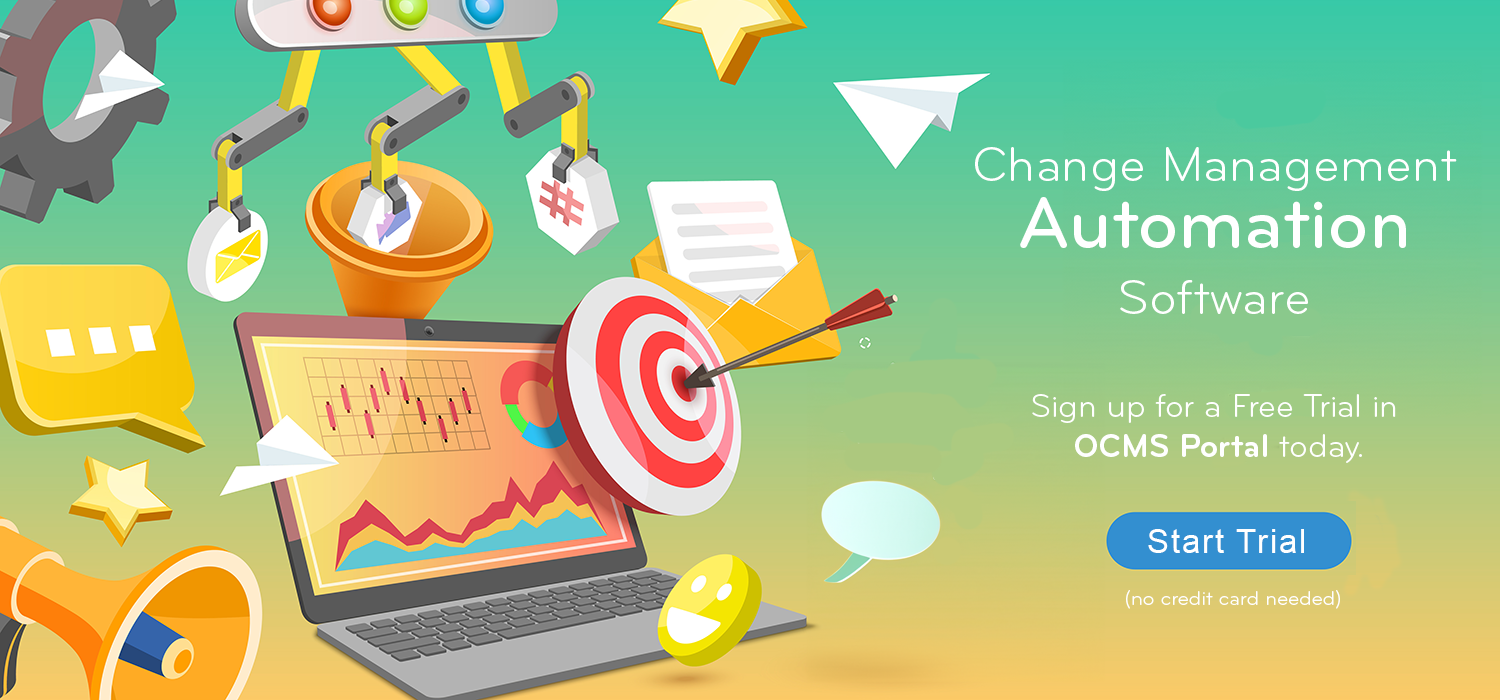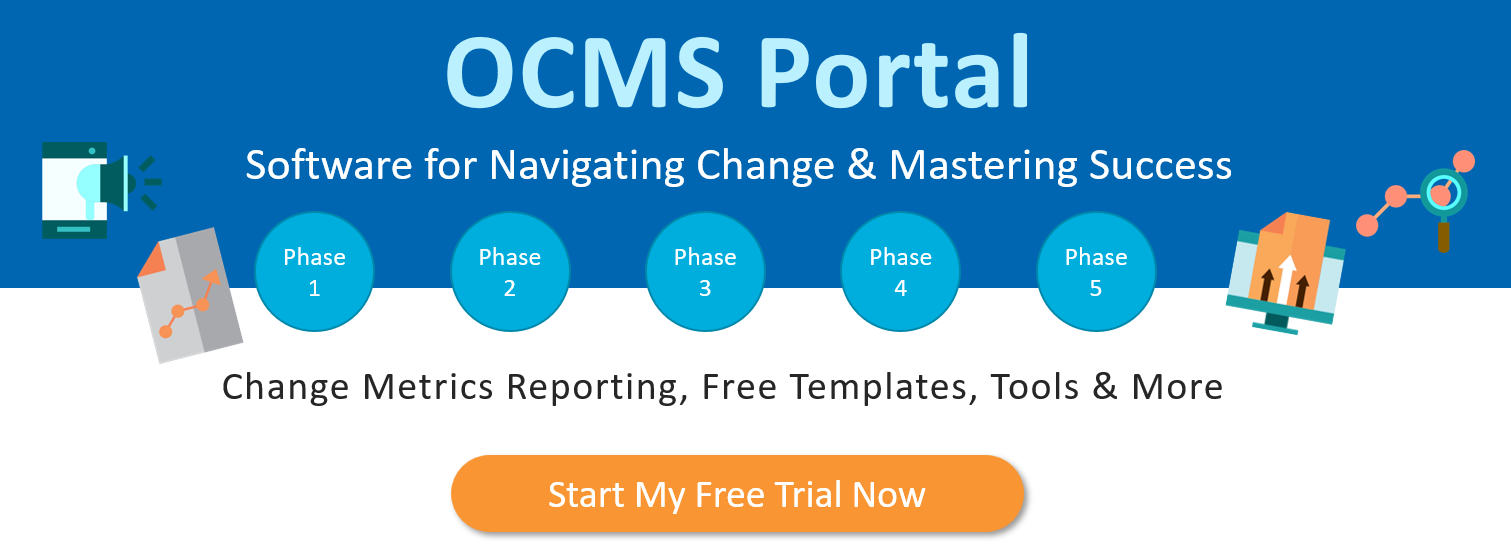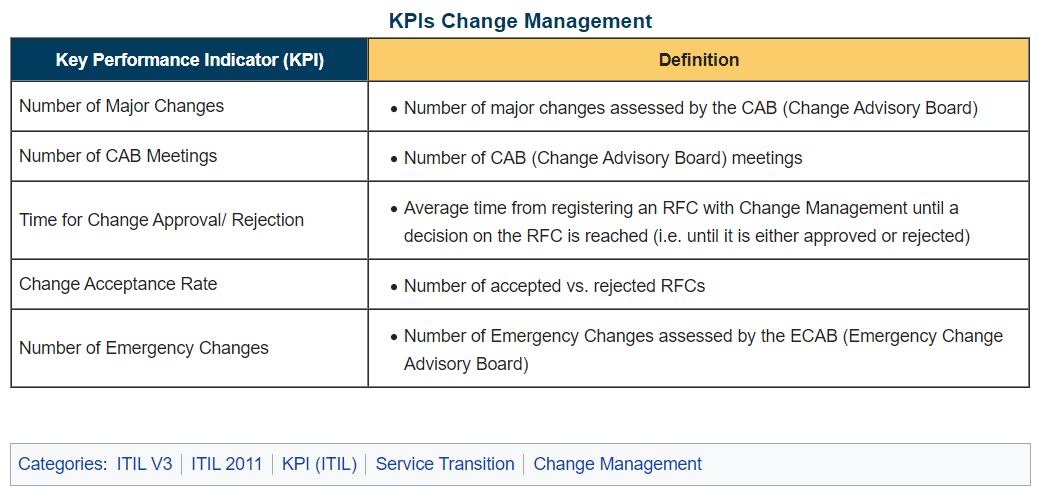Measure Success of a Project Using Change KPIs & OCM Tracking Metrics
Ever wondered how to truly measure the success of your change initiatives? In the ever-evolving world of business, understanding the impact of change is not just crucial—it’s the key to steering your ship in the right direction. Change management metrics and key performance indicators (KPIs) aren’t just numbers; they are the compass guiding executives and key stakeholders toward informed decisions.
This free change management guide provides you with an end-to-end overview of the various OCM KPIs that change management teams and practitioners should track as part of their change programs.
We’ll look at how to measure change success, including who is responsible for defining metrics of change management, and the best ways to report each change management KPI to your management team and stakeholders.
Read a quick success metrics template summary below. If you want to dive deeper, keep reading to sink your teeth into a detailed discussion of metrics for change management.
Quick Summary
 Change Metrics | Your Key Measures of Success for OCM
Change Metrics | Your Key Measures of Success for OCM
Change management metrics and Key Performance Indicators (KPIs), are vital tools for evaluating organizational change progress.
These metrics assess user adoption, communication effectiveness, training completion, and stakeholder engagement to ensure successful project implementation.
Change management teams, responsible for user adoption, employ these metrics to gauge readiness and identify potential risks. Change analytics provide a handy snapshot of how prepared the individuals in an organization are for project rollout. Without them both the OCM team, project sponsors and executives are flying blind, and may not know that a project is about to fail due to the lack of user adoption.
Something as simple as a bar chart or area graph illustrating readiness KPIs like impacted user awareness and knowledge, can give OCM leaders critical knowledge. That knowledge allows them to identify and resolve risk early, so they can keep a project on track.
How do you create metrics to measure employee engagement & adoption?
The responsibility of defining OCM metrics lies with the change process owner, often aided by established frameworks. These metrics assess communication engagement, training effectiveness, and user readiness, guiding the change management process from current states to desired outcomes.
Additionally, key stakeholders of the project (executives, sponsors, supervisors, etc.), may request to know certain information. Such as:
- How and when are all these changes impacting my employees?
- What is the cadence of rollout between all projects happening in the organization?
- How effective are the training courses in ensuring proficiency once the solution goes live?
Leadership most likely won’t ask to see the “Change Saturation by Audience” report or the “Training Course Effectiveness” chart. It’s up to the OCM team to be measuring change results, using change management survey questions and other types of data, to develop and present a change management metrics dashboard.
How do you gather metrics for measuring success of change management?
Gathering essential change management metrics can be a breeze with a few effective methods. Firstly, consider sending out change management surveys to the impacted audiences, capturing their valuable feedback and insights. Engaging directly with stakeholders and entering the metrics based on these interactions offers real-time data, ensuring accuracy and relevance.
Additionally, leverage other tools such as email programs or system logins to collect pertinent metrics. By embracing these diverse approaches, you’ll have a well-rounded understanding of the change landscape, empowering informed decision-making and fostering a smoother transition for all involved.
KPI Planning Template | Evaluating Change Management
Adoption and change management reporting can be divided into two key categories:
1) Change metrics for a specific project that drill down into how user readiness and adoption are progressing for that change initiative; and
2) Portfolio-level metrics that look at OCM metrics for all projects across the organization
Imagine change management as steering a ship through rough waters. At the project level, change metrics are like checking the ship’s components to ensure they work well. It’s detailed, focusing on specific changes. On the other hand, at the portfolio or program level, change management analytics reporting is more like looking at the entire fleet of ships.
It gives a broader view of how all the changes across different projects are progressing, offering insights to make strategic decisions for the entire organization.
So, project level metrics zoom in, while portfolio/program level reporting zooms out, both crucial for a smooth sailing journey!
Portfolio-level Metrics Measuring Transformational Change
These reports provide a broad view for measuring organizational change effectiveness and impact across all ongoing projects.
| Change Impact KPI Tracking | Stakeholder Engagement Metrics | Measure of Change Readiness & Adoption | Other Program Change Management Reports |
| Number of total changes by project | Level of support for the project | Overall project readiness level | Training needs change analytics by project |
| Project impacts across the organization | Stakeholder availability by project | Overall project adoption level | Training success metrics per project |
| Projects impacting customers | Stakeholder type by project | Awareness of the change by project | Communications change management metrics KPI |
| Types of changes per project | Stakeholder risk by project | Acceptance of the change by project | Risk score per project |
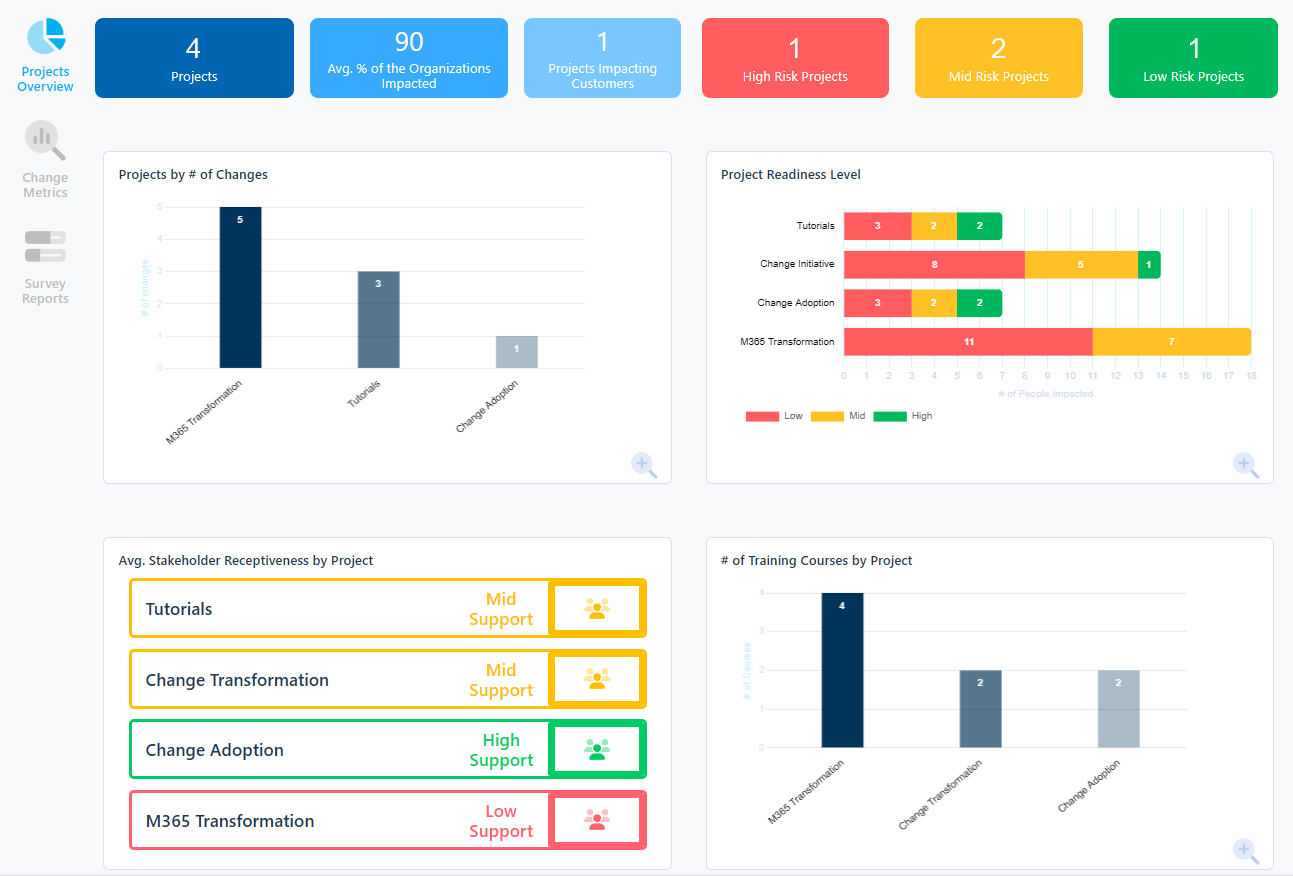
Explore OCMS Portal’s change portfolio management dashboard for mastering change success. Check it out now!
Sign Up for a Free Trial of OCMS Portal Today!
Project-level Change Management Scorecard
Project-level reports look into the granular details of a single project, providing change management monitoring that details project particulars like risk, readiness, adoption, and more.
| Change Impact KPI Tracking | Stakeholder Engagement Metrics | Measure of Change Readiness & Adoption | Other Change Management Reports |
| Level of impact severity by audience | Level of support for the project | Awareness of the change | Training needs by course |
| Number of total impacts | Level of influence on the project | Acceptance/support of the change | Training success metrics by audience |
| Types of changes impacting groups | Availability for learning the changes | Knowledge of what is changing | Communications engagement by audience |
| Change saturation by group | Stakeholder risk scores | Proficiency level | Risk score by stage |
| Adoption risk score by audience | Reasons for resistance by audience |
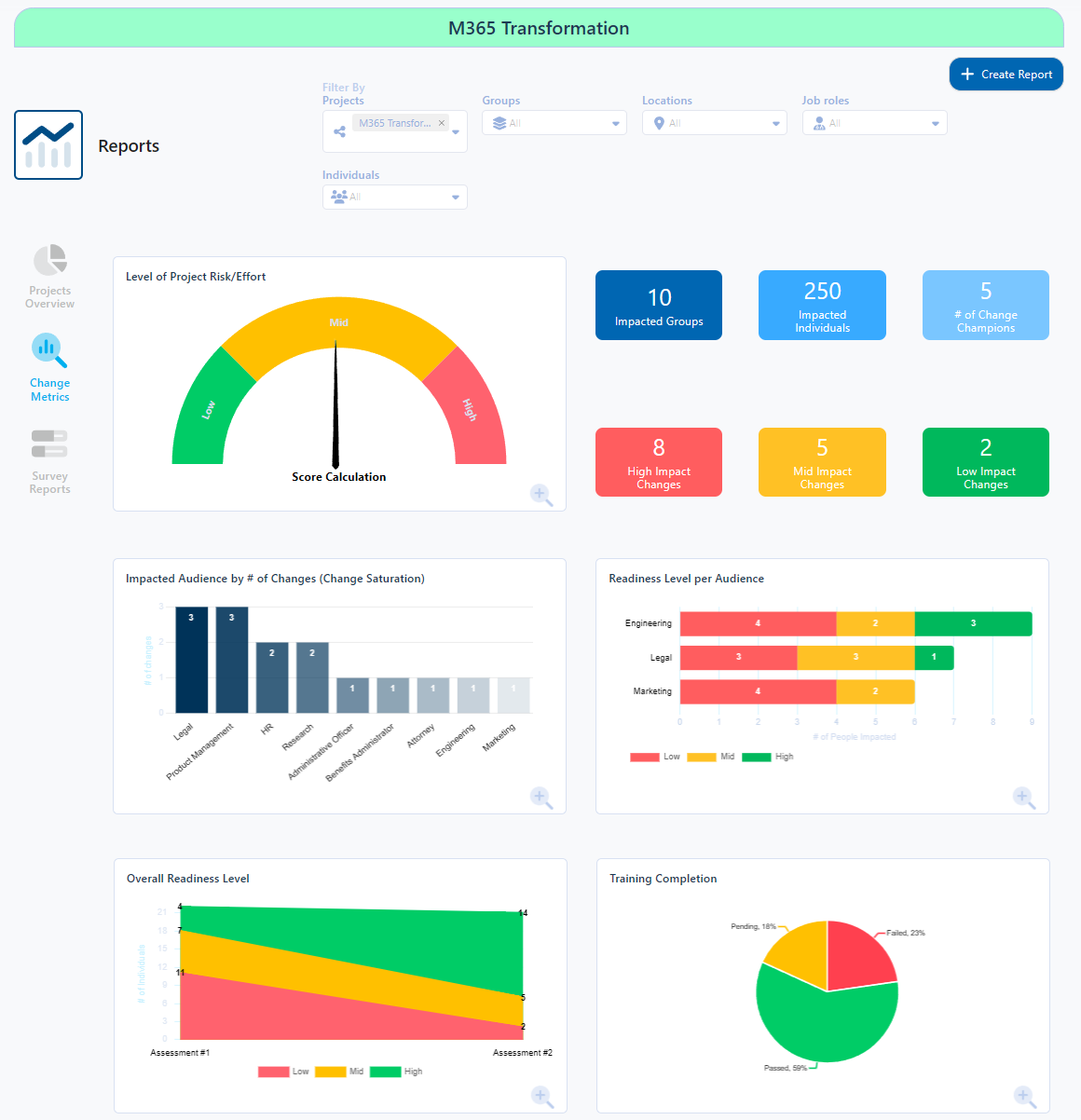
OCMS Portal’s project-level change management dashboard template. When you subscribe, you get simple tools for generating awesome change management reporting. You’ll also have access to over 100 free resources (communications, planners, change management scorecard templates, and more). Sign up for a free trial now.
In conclusion, embracing the right change management metrics is your compass in the ever-changing business seas. Whether at the project or portfolio level, these metrics illuminate your path, ensuring a smoother journey towards success.
Interested in more detailed insights into these metrics and how to effectively implement them? Keep reading for a much more detailed deep dive into how to measure change management success.
Detailed Deep Dive
Complete Guide | Project Management Metrics & Change Management KPI Tracking for Measuring Change Adoption
How do you measure change management and user adoption tracking? How do you know the best metrics and KPI for change management to use? Should you focus on measuring training KPIs, communication KPIs, awareness KPIs, user adoption metrics, or receptiveness to change management metrics?
Or should you take a more holistic view, and track all aspects of change management delivery using an end-to-end change management KPI measurement approach?
 |
Do you have feedback about the change management metrics presented in this guide? Are you confused about the many KPIs change management tracks?
We can help you in your journey to learn more about defining metrics for change management. Contact us to let us know. Also, contact us if you would like to learn more about how to measure success of change management. |
Table of Contents: How to Measure Success of a Project with KPI Change Management Tracking
Keep on scrolling down this page to read each section or click any link below to go directly to that section to see what the KPIs suggested for change management include.
1. My Experience Using Change Management Metrics
2. How to Achieve the Best Change Successes?
3. Benefits of Knowing How to Measure Change Success?
4.What Are Project Management Metrics?
5. What Are Change Management Metrics?
6. What’s the Difference Between a Change Management KPI and Metric?
7. Who Is Responsible for Defining Metrics of Change Management?
8. What Are the True Objectives for Your Change Management Activity?
9. How to Evaluate Change Management Projects | KPIs & Metrics
a. Change Impact KPI Tracking
b. Stakeholder Engagement Metrics
c. Measure of Change Readiness
d. KPI Communications Tracking
e. KPIs of Change Management Resistance
f. Training KPI Tracking
g. KPI of Change Management Coaching
h. Measures of Change Champion Network
i. Sponsor Metrics for Project Success
j. Change Adoption and Engagement Metrics
10. How to Measure Organizational Effectiveness Using Change Management Reporting
11. What Metrics Do You Use to Drive Positive Change?| Change Initiative Types
12. Change Management KPI Metrics in ITIL
13. OCM Tracking Dashboard for Measuring Change Success
14. Conclusion | How to Monitor Change in an Organization with KPIs and Metrics
15. FAQ | How to Measure Change Management Activities
Effective user adoption tracking involves measuring users’ transition from their current to their future states.
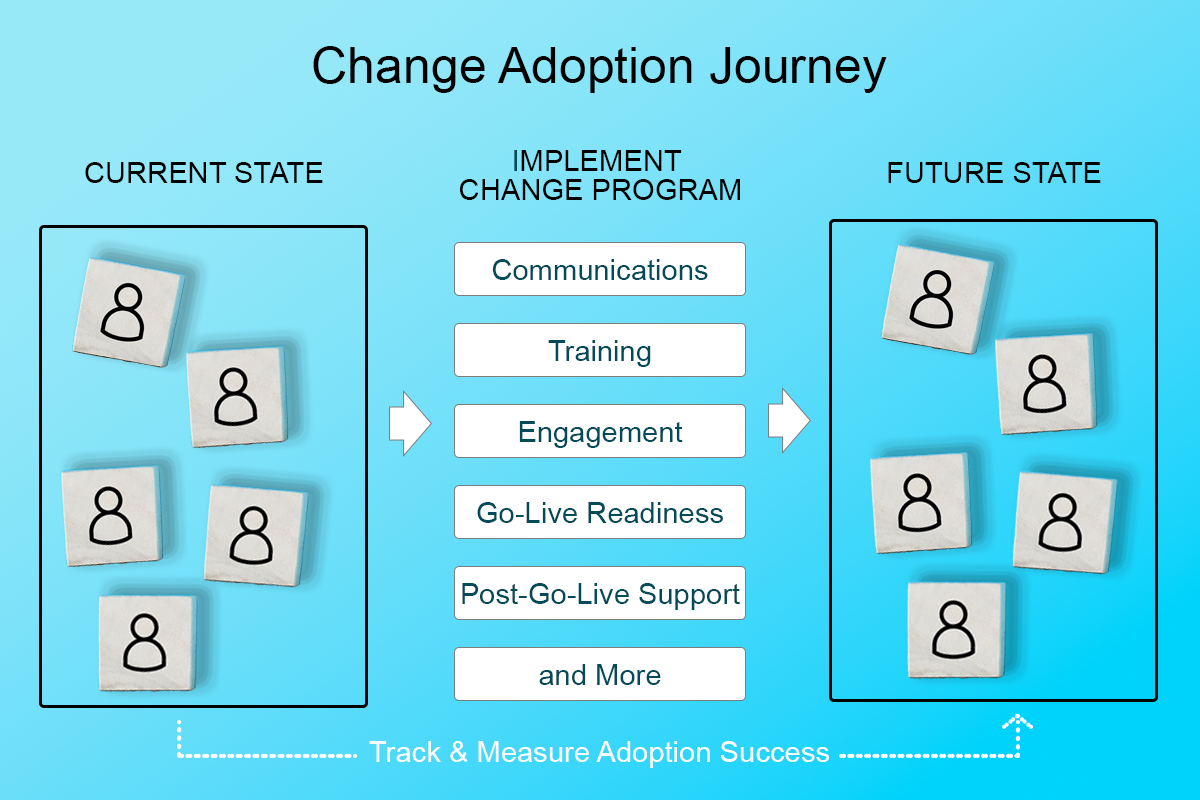
How to Measure User Adoption | KPIs Change Management
After reviewing this guide on the measurement of change, if you still have questions about measuring organizational change, please contact us. Or contact us if you have feedback about the best ways on how to measure successful change management.
Do you have feedback about this guide and the change management KPI examples and enablement KPIs presented? If so, contact us to let us know. Also, if you would like to learn more about the change management measures listed on this page, also let us know.
My Experience Using Change Management Metrics
Over the last 15 years, I have delivered large-scale organizational change management and enterprise-wide business transformations across Cisco, Apple, Goldman Sachs, the Federal Reserve Bank, Intel, State Street, Berkshire Hathaway, HSBC, and a wide range of global organizations.
Throughout my years of experience in change consulting, I discovered that constantly measuring organizational change management KPIs and metrics allowed me to better gauge the effectiveness of my change management activities, and to know what is working, what is not, what should be changed, and when to pivot my change plans to increase user adoption.
Leveraging a change success metrics template that also includes a graphical KPI dashboard increases a change manager’s ability to holistically gauge all aspects of his or her change management successes.
Keep on reading for a step-by-step review of the best change management KPIs and metrics that you can leverage to increase your change adoption deliverables.
As Pioneers in this sector, our goal is to continue educating and supporting the change management and program management communities across the globe. Let us know if you have any recommendations on how we can continue building this partnership or feedback on the change management measures presented in this guide.
Ogbe Airiodion
OCM Solution Founder
Senior Change Management Leader & Consultant
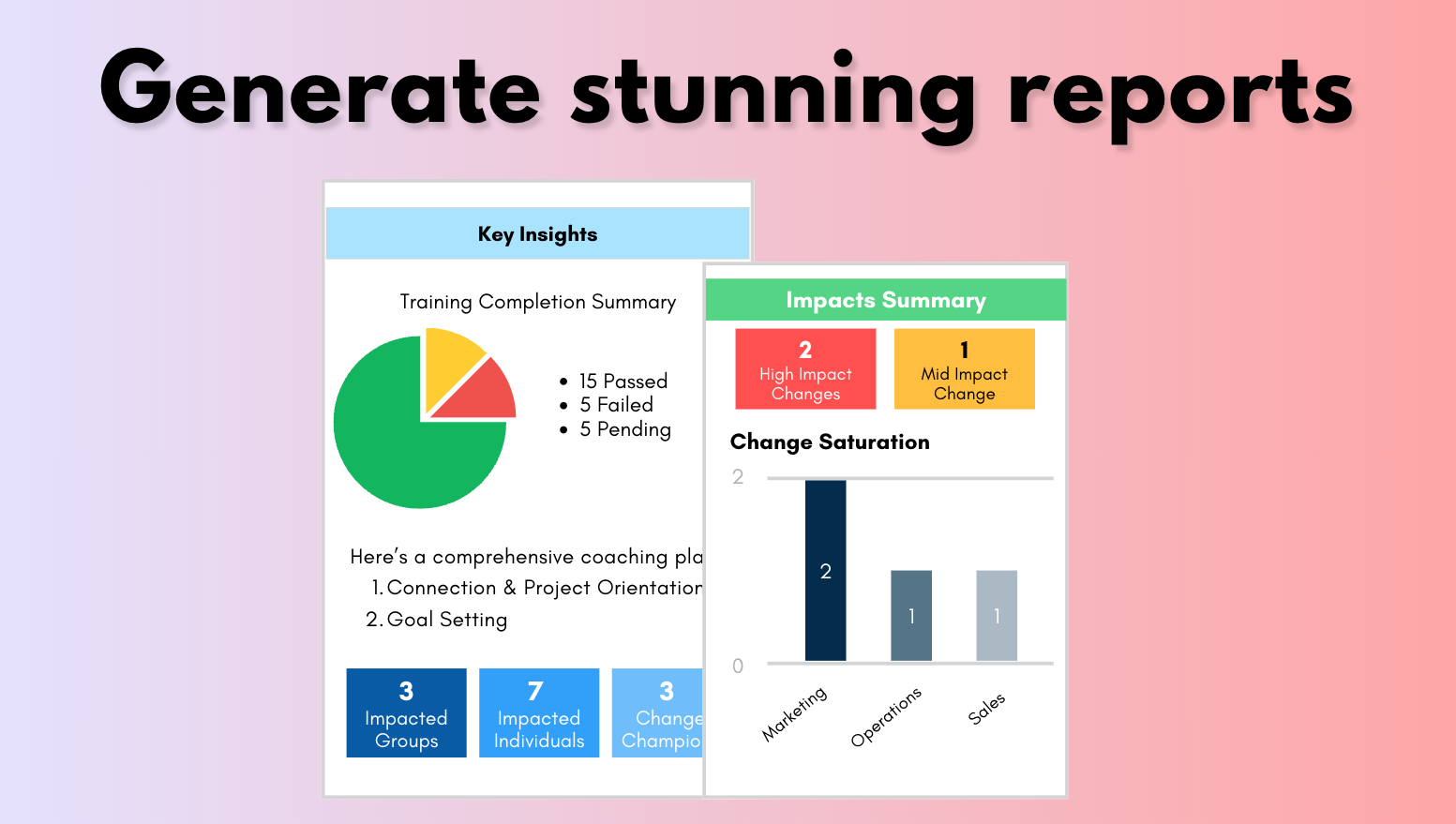
Sign Up for a Free Trial of OCMS Portal Today! (no credit card needed)
Note
This end-to-end guide on measuring organizational change can be a lot to take in.
We understand.
As such, we have developed an industry-standard, automated Change Management KPI Measurement Dashboard you can use to increase your performance and success.
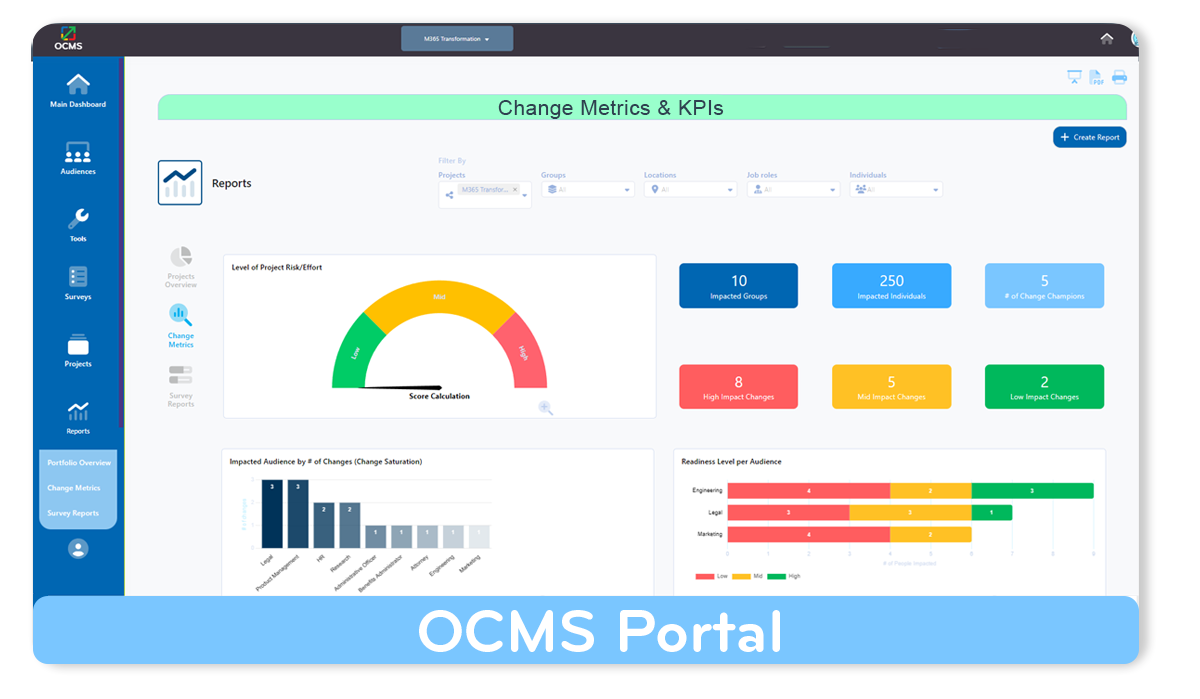
Click here to learn more about this software tool to measure change management performance
Although this guide is focused on tracking the people side of change (organizational change management user adoption tracking), if you are an IT Manager and are interested in learning about the best ITIL change management indicators, click here: Change Management KPI Metrics for ITIL.
How to Achieve the Best Change Successes? Change Management Metrics Examples
To achieve the best change management success for projects, you’ll need to track how users and impacted groups are transitioning through a project-driven change using these industry standard KPIs for change management.
These KPIs for change management can be applied to any initiative that involves a people, policy, process, culture, M&A, data, integration, or technology change.
Your key stakeholders and management will want to see your change management KPIs that show how a project is progressing and will request that you show them your change management performance indicators and reporting. Oftentimes these stakeholders will also want to see key data points and change management KPIs across several change management areas including communications, training, leadership support, change adoption, resistance management, and more.
Projects aren’t successful unless people adopt the project solution, which involves changing something they do. Knowing how to measure successful change management through the right metrics to drive change gives you a “superpower” to enable project success.
Do you have feedback about the change management success metrics presented in this guide or questions related to the Prosci change scorecard? If so, contact us to let us know. Also, contact us if you have used other best change management measurement KPIs for your projects.
Benefits of Knowing How to Measure Change Success (KPIs Change Management)
What are the benefits of knowing how to measure change management? The benefits of knowing how to measure the effectiveness of change management include:
- Give insight into success metrics for a project
- Ability to proactively act to address risks to project success
- Transparent and informative reporting on how change management activities contribute to a successful project
- They provide an important method for monitoring organizational change and it’s impacts
- Able to pinpoint successes and areas of concern in the KPIs for change management
- Measuring change and adoption vs engagement metrics enable you to show progress toward the goal
What Are Project Management Metrics? Defining Metrics for Change Management
Project management metrics are the respective KPIs used to track the success of a project and are the foundational blocks for defining metrics for change management.
There are many different change measures for a project. There is tracking the number of project design deliverables that are still pending, for one. There is also tracking of things like a communication KPI to see how many emails were read by the recipients.
How to measure success of a project is best divided into two distinct areas:
- Project Management Metrics; and
- Change Management Metrics (explained in the section below)
A project metrics template would include reporting pertinent to the implementation and deployment of the project. Project teams are responsible for designing, developing, testing, delivering, and maintaining solutions.
For example, one project metric may be a count of how many bugs identified during user acceptance testing (UAT) for a new software have been fixed and how many remain. The value of this type of project change metric is to estimate the timing for when the software will be ready to deploy.
Success metrics for a project also go beyond the technical delivery of the project solution and look at hard numbers such as return on investment and payback time. Projects are typically implemented in the first place because they provide some type of value to the organization. If projects don’t reach that value, then the investment of time and money may not have been worth it for the company.
Typical project management metrics are:
- Return on investment
- Time to payback
- Dollars spent versus budget
- Earned value
- Productivity
- Time of delivery versus timeline
- Found bugs/problems
- Stakeholder/user/customer feedback
Project teams are responsible for designing, developing, testing, delivering, and maintaining solutions.
The section below provides an overview of the best ways for defining metrics for change management.
What Are Change Management Metrics?
Change management metrics are the key performance indications (KPIs) used for measuring organizational change successes and progress. Change practitioners use change metrics to drive change and increase user change adoption of business initiatives.
Are users adopting the changes the project requires? Do teams know about the changes impacting their workflows? Has training been completed? These are all metrics for change management, and they help the change management team understand if the people that need to adopt the project solution are ready to do that.
Change management teams are responsible for helping impacted users embrace, adopt, and become proficient in using the new solutions. These types of change management statistics are linked to project success, because if people don’t adopt the changes, tools, processes, or systems the project requires, then the project can’t meet its ROI and value objectives.
Typical change management metrics are:
- External communications KPIs
- Internal communication KPIs
- KPI for training and development
- KPI awareness metrics
- Stakeholder engagement KPI examples
- Adoption change management KPIs
- Sponsors and leadership metrics examples
- Resistance monitoring change management metrics
- Post-training delivery change management feedback
- KPIs for organizational development coaching
- Change success rate across projects
- Adoption metrics vs engagement metrics
- Change champion network coaching & training KPIs
Change management teams are responsible for helping impacted users embrace, adopt, and become proficient in using the new solutions.
What’s the Difference Between a Change Management KPI and Metric?
A metric and a KPI for change management can often refer to the same exact thing. The terms metrics and KPIs are often used interchangeably, whether you’re talking about adoption metrics project management uses or about change management success criteria.
However, there is a distinction between the two. For example, a KPI communication report refers to a key performance indicator – KPI. Communication metrics on the other hand is a more general term. It includes all reporting data, not just those that are considered “key” indicators of performance.
So, communications metrics (and other types of metrics for change management and project management metrics) will include communication KPI examples. But something considered a KPI for communication skills or engagement is a special metric. It’s a metric that is a key indicator of communication engagement performance.
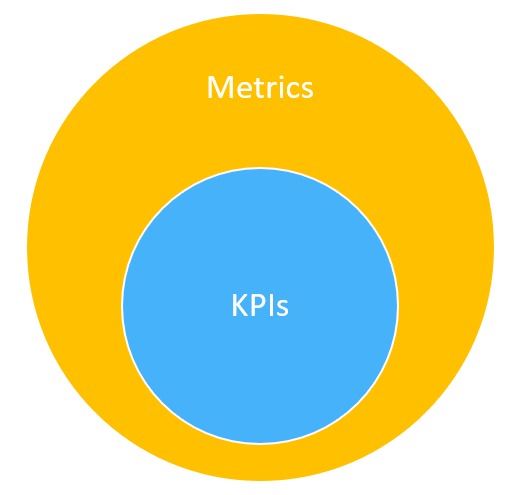
Change management measurement includes KPIs for change management, which is one category of metric used to measure change success.
Are there specific types of change metric questions you have? Such as how to measure organizational effectiveness, how to measure change adoption, or how to measure change management readiness. Reach out and let us know.
Who Is Responsible for Defining Metrics of Change Management?
When working with a metric or KPI in change management there is a decision that needs to be made before gathering the data. This decision is how to measure success of change management activities and the end result.
In other words, what metrics are going to be used for measuring change in an organization and will let the team know both the risk areas and when change is adopted successfully?
The KPI change management process is something you determine early in the project. Who drives this decision? Who is responsible for defining metrics of change management? It’s the change process owner.
The change process owner coordinates with the project sponsors and project management team to determine what type of reporting on measuring change management success needs to be in place.
However, the change process owner doesn’t have to start from scratch to identify how to measure change management effectiveness, there are already frameworks in place to guide them. For example, the OCM Solution Change Management Framework lays out the key metrics for measuring change management success.
When using the OCMS Portal’s change management metrics & KPI reporting dashboard, the defining metrics for change management are already handled for you, based on change management best practices.
From a change management effectiveness survey to end-to-end pre- and post-go-live reports, you have everything you need for reporting on organizational change management metrics.
See the results of your change management evaluation across the entire project (communications, impacts, stakeholders, adoption, and more).
Learn More About this Change Management Tracker Platform
Do you have any questions about how to determine if change is successful, a cascading KPI template, ADKAR questionnaires, the Prosci change management scorecard, or how to read a performance change management report? Please reach out and let us know.
What Are the True Objectives for Your Change Management Activity?
The true objectives of any effective change management enablement program include increasing the success of a project, initiative, social, cultural, policy, or organizational change.
A change can involve implementing new business processes, system integrations, technology changes, merger and acquisition integration, business expansion, new product roll-out, a change to a company’s organizational culture, re-organization, new company vision, or any type of change that involves going from a current state to a different future state.
To determine whether change adoption and enablement activities are successful, you need to track how impacted audience groups are reacting to and adopting the new solutions. This includes measuring employee engagement metrics.
If you’re tracking a KPI for communication, ask yourself, “What connects to telling me if the project is on the right track to being successful?” A KPI internal communication metric can be many things. You want to ensure you’re evaluating communication strategies in the best way possible for a particular project.
It may be how many users read the email because if they don’t read it, their awareness of the change and what they need to adapt will be low. This means low change readiness, which means the project is at a higher risk of failing.
Some training KPI examples would be to track how many people said they still need more training after they went through the planned training program. Using an ADKAR survey, OCM Solution survey, or another training metrics template survey, you could ask the question, “Do you think you still need more training?”
This is connected to measuring training success. If most people say they still feel they need more training after they’ve finished the planned training, that indicates training wasn’t successful at teaching them what they needed to know. More training will be required to prepare the groups for the changes they need to adopt.
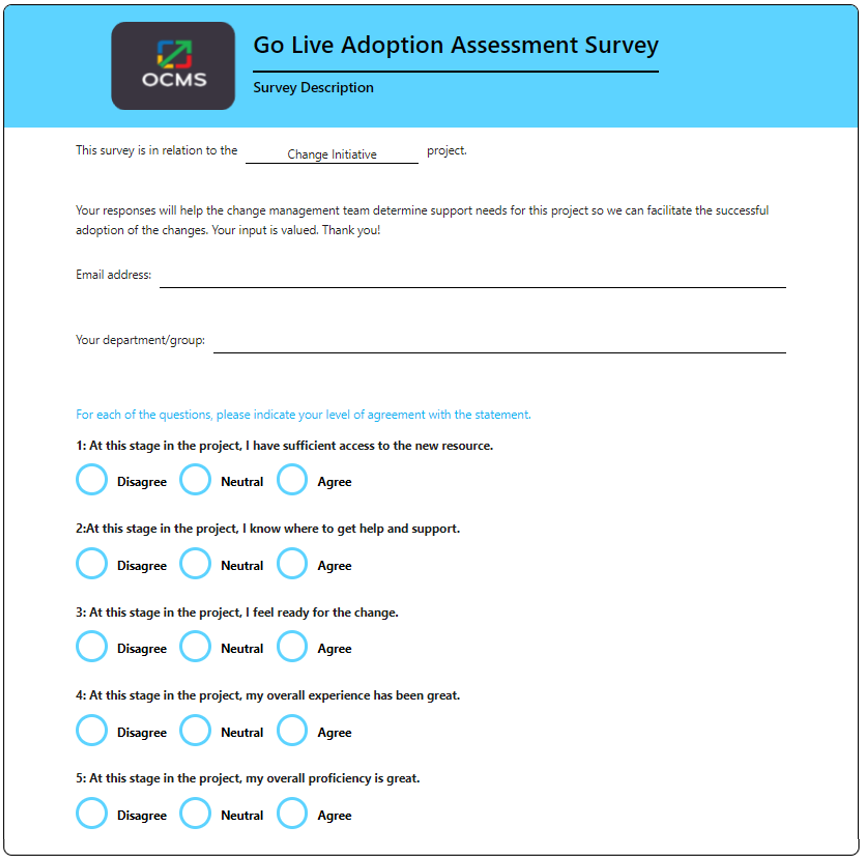 What metrics do you use to drive change adoption? The adoption metrics change management teams use are a mix of “people” metrics and “data-driven” metrics.
What metrics do you use to drive change adoption? The adoption metrics change management teams use are a mix of “people” metrics and “data-driven” metrics.
“People” change management adoption metrics include asking people something like, “Do you feel ready for this change?” they are metrics coming from the perspective of the impacted audiences. It’s important to know whether or not they feel ready, whether they know where to get help and support, and similar adoption and normalization-related questions.
Data-driven methods of evaluating change management include evaluating how many employees logged into the new software system and set up their accounts. This gives you hard data on whether people are using the new solution just deployed and actually adopting it.
Continue scrolling down and reading this step-by-step guide on metrics to drive positive change for a more detailed answer to, “How do you measure the progress of change?”
Don’t forget that you can use the OCM Solution Change Management KPI Measurement Dashboard, part of the OCMS Portal change management platform, for managing all aspects of your organization’s success of change management for a project. It includes a sample questionnaire on change management for many of the metrics (adoption, readiness, training & more!).
How to Evaluate Change Management Projects | KPIs & Metrics
How to Measure Change Overview
This section covers in detail the various metrics used to measure change management success for a project. This includes measuring communications metrics and KPIs for internal communications, KPI for training manager reports, how to measure employee engagement metrics, adoption KPIs, and other key measures of success.
The goal of effective change management is to increase the success of a project, initiative, or organizational change. How to measure change management is done through effective communications, stakeholder, and impacted users’ engagement, training, coaching, and change reinforcement to get impacted users to embrace and adopt the change.
To track the success of the change management resource/team’s activities, you need to track whether the change management deliverables and plans are meeting their respective objectives.
For example, when you send a communication, a key objective of that communication might be to spread awareness and keep users informed about a change. Another objective might be to instruct users to perform one or more actions (test their access to a new solution, visit a page, etc.). These are your external audience or internal communications goals.
To track the success of your communication, you need to track whether users are getting the needed awareness or whether they are performing the required actions. If they are, then your communications are meeting their objectives. Measuring communication successes and engagement communication KPI examples is a critical part of change management metrics that should be tracked.

Stakeholder engagement and support are important change management metrics examples.
When you engage with stakeholders, your aim is to increase stakeholder support for the change. As such, when measuring stakeholder engagement, you should include the effectiveness of your engagement activities.
If you find that support hasn’t increased as you intended, it may require rethinking your stakeholder engagement strategy in order to get the desired outcome.
These are just a couple of stakeholder management KPI examples. Another of the stakeholder engagement KPIs that’s important to know is how influential a stakeholder is to a project. Stakeholders with a high ability to impact or influence project success are a high priority to engage with, especially if their support is low.
When you provide coaching and training, you aim to equip impacted employees, managers, and customers with new skills and knowledge that will enable them to effectively use the new business solutions. As such, in this case how to measure the success of change management should include the effectiveness of your training, leadership support, change reinforcement training, and coaching objectives and activities.
An increase in user change adoption has a direct correlation to the effectiveness of your change management activities. The more efficient your change management plans and activities are, the higher the rate of user change adoption.
List of Change Management Metrics and KPIs
- Change Impact KPI Tracking
- Stakeholder Engagement Metrics
- Measure of Change Readiness
- KPI Communications Tracking
- KPIs of Change Management Resistance
- Training KPI Tracking
- KPI of Change Management Coaching
- Change Adoption and Engagement Metrics
- Measures of Change Champion Network
- Sponsor Metrics for Project Success
Next, we’ll delve deeper into the importance of measuring change and key performance indicators that could be used to measure changes by looking at change management success metrics for each area of the change management workflow.
Would you like to know more about how to communicate metrics to leadership, how to develop internal communication goals, or about any other change management measures? Just reach out anytime and our OCM experts will be happy to help!
Change Impact KPI Tracking
Wondering how to measure organizational change? You start by looking at the impacts of changes on those being impacted. One of the first assessments that you need to conduct in change management activities is the change impact assessment. This drives who you will need to track and engage, the priority of which groups to engage with first, and the amount of engagement they need.
Highly impacted stakeholders need more engagement than those only being impacted minimally by a project. Before you can track things like internal communications objectives examples or training KPIs examples, you need to know which groups need communication and training, thus a change impact KPI is an important driver of your entire change management plan.
Change management metrics examples for change impacts are:
- The level of impact severity
- The number of total impacts (aka change saturation)
- The types of changes impacting groups (technology, role, policy, etc.)
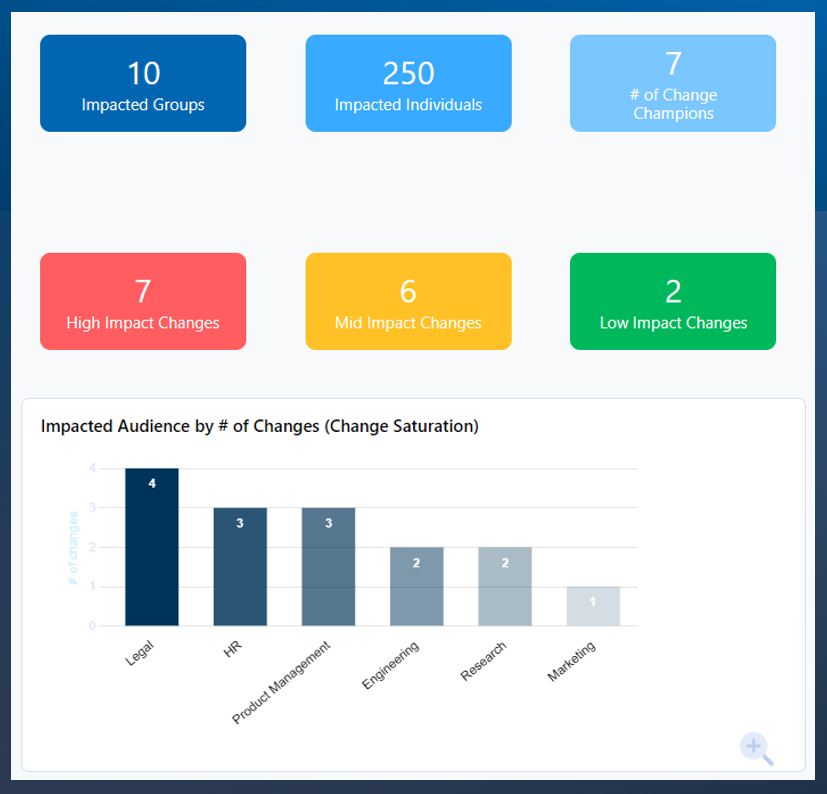
Change Management Dashboard Example | Change Impact KPI Reports from the OCMS Portal Software.
Stakeholder Engagement Metrics
When first engaging with the stakeholders in your impacted groups, it’s important to assess them to identify an engagement game plan. For example, some of the data you’ll need to generate stakeholder management KPI metrics include the stakeholder’s level of support or resistance to the project, their capacity to learn the required changes, and their level of influence.
If a stakeholder has a strong influence on the project’s outcome or how other stakeholders may or may not adopt the changes, and they have a low level of support, a high-priority engagement plan is needed to reduce the risk of project adoption failure.
Stakeholder engagement KPI examples include:
- Level of support for the project and changes
- Level of influence/impact on the project
- Availability (aka bandwidth) for learning the changes
- How successfully the stakeholder engagement is progressing
Measuring employee engagement metrics can be as simple as sending them a survey, like the ones built into the OCMS Portal change management cloud software. Survey answers populate into both the assessment and the related reports automatically as individuals submit their surveys.
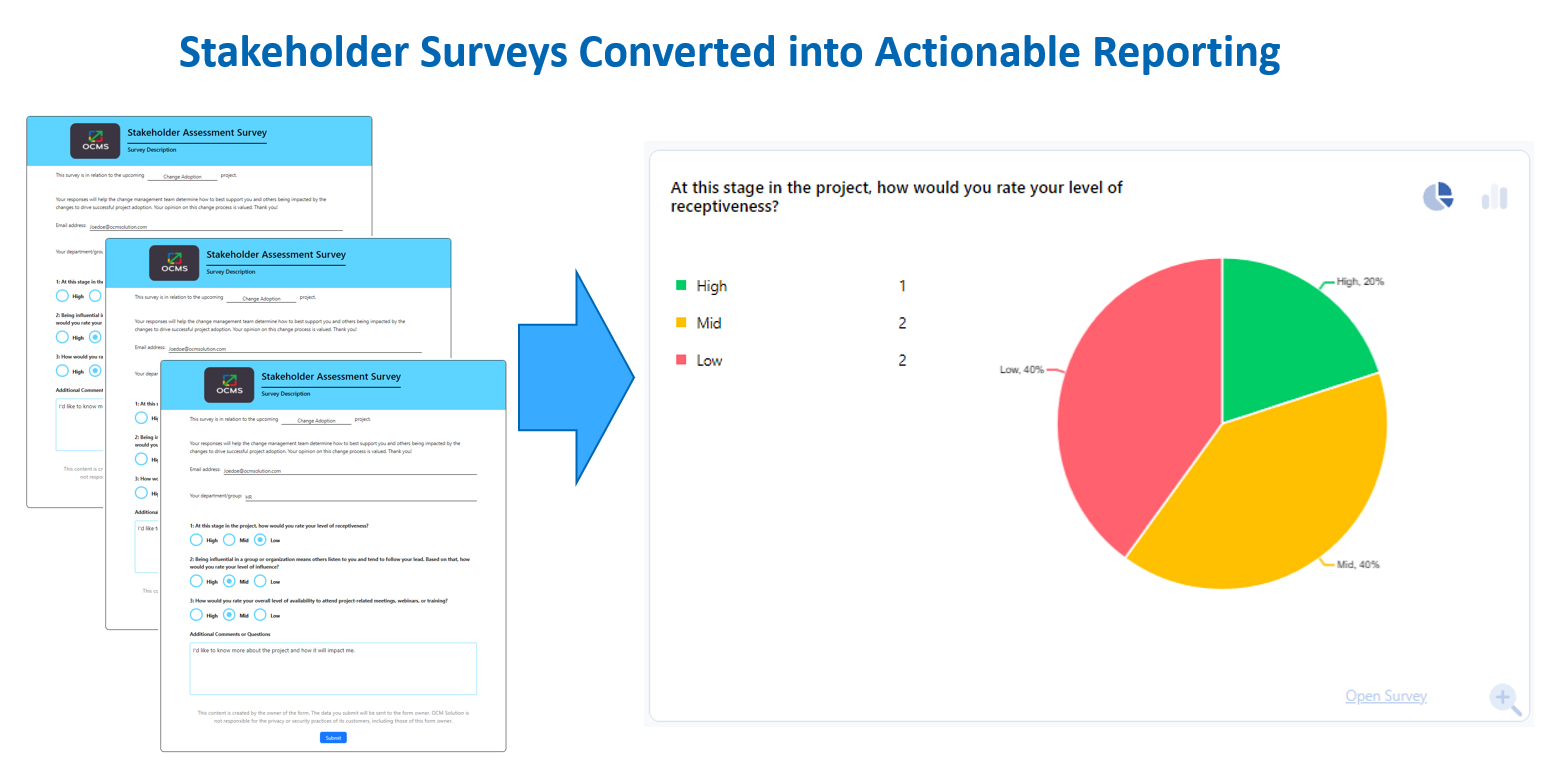
Example of measuring stakeholder engagement & impact. Try out this and several other change management questionnaires in the OCMS Portal. Start for free now.
Measure of Change Readiness
Preparing impacted groups to adopt upcoming changes is the heart of what change management is all about. This is done through readiness assessment and tracking of readiness change management KPI examples, such as awareness, support, knowledge, capacity, etc.
One of the most efficient ways to capture readiness and adoption metrics examples is to use a survey. You can use ADKAR survey questions to assess readiness, the OCMS Portal readiness metrics survey, or another change management awareness survey.
OCMS Portal Tool to Capture Readiness & Change Management Effectiveness KPIs
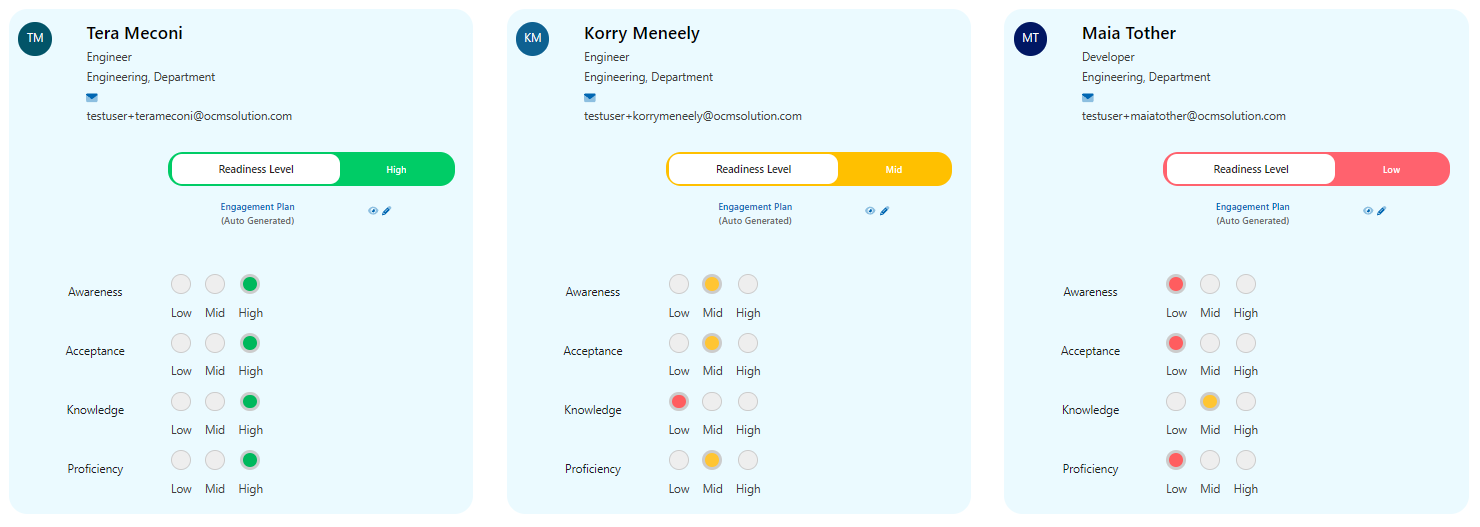
Example of the change management effectiveness survey populating answers in an assessment to measure readiness KPIs. This is one of the many change management evaluation tools included in the OCMS Portal software (a Change Metrics & KPI Dashboard is included!)
Other change management performance review examples for tracking change readiness KPIs include meeting with selected managers and asking them directly how well their direct reports are reacting to the communications, and how aware they are of the change.
Whether you are tracking KPIs for culture change, need to track management changes during a project, or are using a KPI for training effectiveness during a merger, readiness metrics will be key KPIs that need to be reported on.
Here are the main readiness metrics tracked on a readiness adoption metrics dashboard:
- Awareness of the change
- Acceptance/support of the change
- Knowledge of what is changing
- The level of proficiency in the new changed behaviors
KPI Communications Tracking
Communications are a vital part of driving many of the other adoption success KPIs used in change management. This is why you’ll see that this section on how to evaluate communication success is longer than the other metrics that give insight into the effectiveness of change management.
For example, awareness communications help increase one of the key measures of success for readiness, which is awareness. If your communications metrics dashboard tells you that all the awareness communications have been sent, but users fill out a readiness survey and you see awareness is low, it’s your communication metrics examples you need to check – such as did most recipients receive the communication? Did they read it?
When using a training metrics dashboard to track a sample KPI for training and development, communications effectiveness also comes into play because people must have communications about the training when it’s being held, and to facilitate post-training survey deployment.
For some projects, you may be tracking both external and internal communication KPIs (for groups inside and outside the organization). For other projects, you may only need to track internal communications KPIs, if there are no external impacted stakeholders.
Regardless, of whether you are tracking for an external or internal communications KPI, the metrics you track will be similar. Below, we’ll get into how to measure internal communications or external communications and what to include on a communications measurement dashboard.
Here are some communication KPIs examples of what to track and how:
1. Reach / Open Rate
Reach, which is also referred to as Open Rate, is tracking the number and percentage of people that are opening your communication. To calculate your communication Reach, divide the # of opens by the # of email recipients. Many types of communication measurement tools provide this count for you automatically
2. Communication Engagement
Effective external communication or internal communication gets the response you are looking for from the recipient. For example, do you need them to learn something new about a change? Do you need them to sign up for a webinar introducing the transition details?
Communication engagement metrics demonstrate how recipients are interacting with your communications. Engagement metrics can help you identify which teams are the most engaged based on time spent viewing the communication (most external and internal communications dashboard tools have a “time spent on the email” tracking feature).
-
- Click-through Rates: You can also track click-through rates: # of people that are clicking on the links within your communication. Higher click-throughs mean more engagement, which often equates to more readiness, so this is an important KPI communication factor to track.
- Forwards/Shares: With communication KPI engagement tracking, you can also track how often the email was forwarded or shared. The higher the number, the higher your engagement success.
3. Outcomes
Tracking Outcomes involves tracking specific objectives you want users to perform or complete. For example, if you want users to log into a new CRM solution to test their access, you can state that in your communication and ask users to respond with an “I have access” or “I do not have access.” When a high number of people are carrying out the required actions, your communication is reaching its Outcomes’ objectives. The higher the Outcomes, the higher the success of that communication. These communication KPIs objectives can be added to your communication template, if using the OCM Solution Change KPI & Metrics tool, you’ll see the success metric on your communications metrics dashboard.
How to Evaluate Communication Effectiveness
- Leverage the built-in tracking features in communication measurement tools
- Solicit feedback during meetings from communication recipients
- Ask change champions to ask their colleagues if they are aware of (and have read) the communication
- Send out a communication metrics survey to comm recipients
- Engage with change champions to get their input on “water cooler employee conversations” on the change, as well as have them pass direct end-user feedback to you. Communication KPI examples of questions to ask them:
- Do employees and managers feel your communications are too many, or not enough?
- Do they prefer more specific types of communication?
- Would employees and managers like to receive these communications differently from how the change team is providing them? (e.g., in a newsletter format versus email?)
Keep track of these communication change measures in one place so you can easily report on them and create any type of communication success metrics you need. Measuring internal communication effectiveness is easy when you can choose your own methods to measure. Here’s an example from the Communications Management tool inside the OCMS Portal.
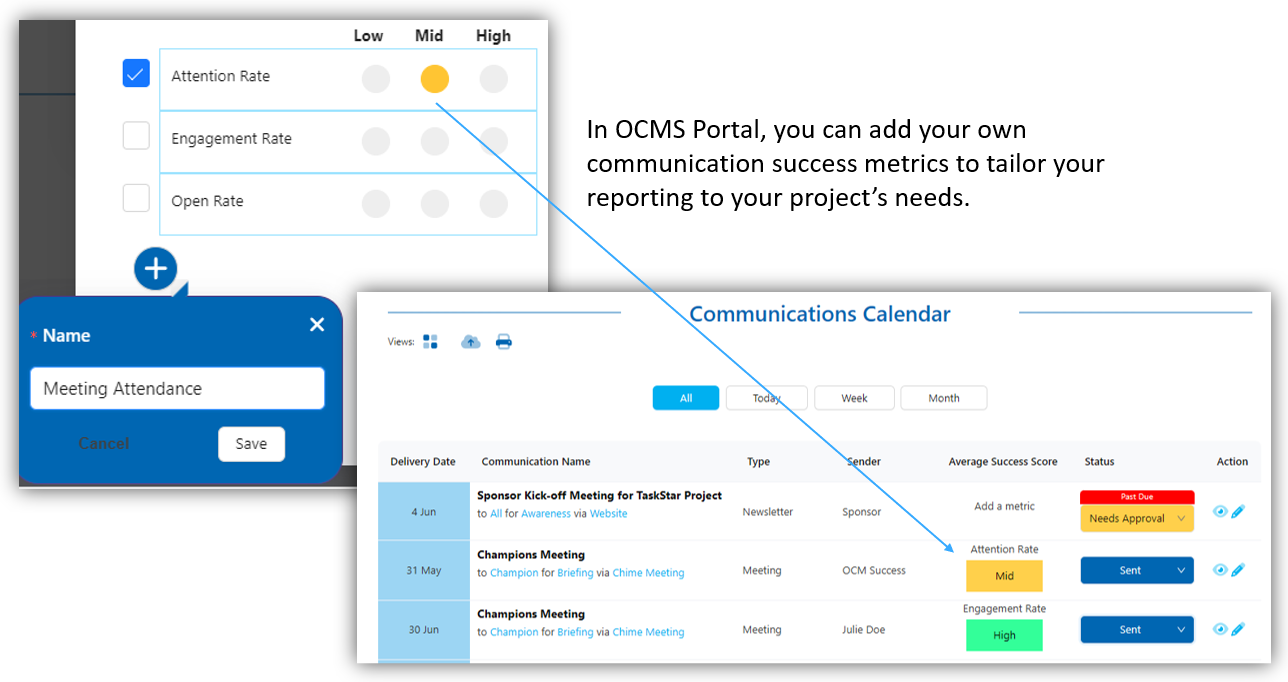
Do you have any questions about communications metrics, setting internal communications goals, post change management survey questions, or tracking external or internal communication KPI examples? Just reach out and we’ll be happy to help.
KPIs of Change Management Resistance
A lack of receptiveness to change is another key reason why change and projects fail. As such, measuring change management effectiveness should include tracking the receptiveness (or resistance) to a change. This is an important KPI for change management because those that are resisting a change are likely to fail to adopt that change, and instead retreat to the “old way” of doing things.
How to measure success of a project by measuring receptiveness (or resistance) to a change is done in a few ways. The best way is to get direct feedback from employees and managers, and also to engage with change champions.
Draft and send out surveys and questionnaires to measure receptiveness to the change, as well as how willing employees and managers are to support and participate in the change. These could be ADKAR survey questions, an OCMS Portal resistance assessment survey, or another survey.
In addition, you should meet with managers to get their input on overall engagement levels for the project. Are their direct reports excited about the change? Are there concerns?
You should also engage the change champions to get their input on overall engagement levels for the project to increase your change management success rate. Are their colleagues excited about the change? Are there concerns you should be aware of? All of these are information that should be included when measuring change management effectiveness.
And don’t forget to ask for and get direct feedback from users during 1-on-1 meetings, group meetings, open forums, workshops, and other engagement sessions to determine how well stakeholders and employees are providing their buy-ins and willingness to support and participate in the change.
Resistance KPIs to gauge the effectiveness of change management include:
- Reasons for resistance
- Level of resistance
- Level of ability to impact/influence the project
- Availability to engage with the change team (e.g., meet to discuss their points of resistance)
Change Management Tracking Template & Dashboard
 OCMS Portal Change Adoption Metrics, Template, and Dashboard
OCMS Portal Change Adoption Metrics, Template, and Dashboard
Include Training KPI Tracking to Your Change Management Measurement Metrics
Many types of projects require users to be formally trained on a new process, software tool, system, or workflow. In this case, training KPIs are important to ensure that stakeholders learn the required skills and behaviors to successfully adopt the project-driven changes.
A sample KPI for training and development manager tracking on a change management KPI dashboard may be how many trainees stated the training was helpful. Other training metrics examples would include the number of trainees passing the training and the number that need to retake it.
Tracking these particular change metrics on a training KPI dashboard will allow you to quickly determine how well end-users are adapting and learning to use the new solutions and processes.
How to measure training KPIs:
- Measure the relevance and usefulness of the training via surveys, questionnaires, or talking to learners during and after the training to collect their feedback. Topics to cover:
- Was the course content relevant and easy to follow?
- Ask questions about what was learned, as well as key takeaways.
- At the end of this assessment, you should have a good understanding of how well the training was received and determine any gaps in the training content.
- Measure the knowledge and skills gained by learners as a result of the training. To measure this level, you can use a combination of training KPI metrics such as:
- Test scores during and after the training
- COLT scores
- Course completion and certification
- Supervisor report and feedback
- After Go-live, make sure to follow up with trainees to measure how the training has impacted each learner’s performance using:
- Self-assessment questionnaires
- Informal feedback
- Focus groups
- On-the-job observation
- Job performance key performance indicators (KPIs)
- Customer surveys, comments, or complaints
KPI for Training and Development Examples to use on a training effectiveness dashboard:
- The level of training needed
- Training status (completed, failed, proficient, etc.)
- Training satisfaction
- Number of trainees per training program
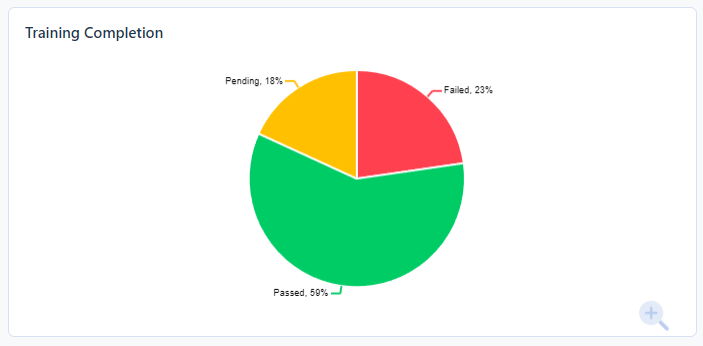
Training metrics dashboard from OCM Solution’s OCMS Portal Training Tool
If there are any other Training KPIs, KPI for training manager metrics, training KPI examples, or ways to measure change management training or other activities you think we should add to enrich this article, please let us know. Additionally, if you’re looking to benchmark three scenarios of organizational change, we can help.
KPI of Change Management Coaching
One of the KPIs change management teams refer to is related to coaching. Coaching is often used to provide the skills and knowledge someone needs to help drive a successful change. Change management evaluation tools for coaching include surveys and direct interactions.
For example, managers may need coaching to understand their role in supporting and promoting the transition to their direct reports. New change practitioners may also need coaching to develop change management skills. In these cases, success metrics for a project would include coaching metrics.
Coaching change measurements & metrics include:
- Level of experience in the subject being taught
- Enthusiasm level for receiving coaching
- Availability for coaching activities
- Coaching success scoring
Include Measures of Change Champion Network to Your Change Management Measurement Metrics
One change management activity that helps to improve change adoption success is to set up a network of change champions/agents. Change Champions are peers in a department or team that can help champion the change at a more personal level.
Your champions network can also help you gather other change measures, such as communications KPIs, awareness KPIs, user adoption metrics, and more. They do this by asking their colleagues in an informal setting how things are going and observing how they are managing the change. Then they report back with insights to the change management team so they can adjust engagement plans accordingly.
Some change management statistics to gather for a Change Champion Network include:
- Level of past change management experience
- Level of coaching/training required
- Availability for champion network activities
- Performance success in completing champion network expectations
A change management feedback survey is a great way to gather many of these metrics.
Sponsor Metrics for Project Success
A high level of support, involvement, and engagement from project sponsors will have a direct correlation to the success of your change adoption and end-user enablement. How to monitor change management includes monitoring sponsor support and involvement.
Users look to the leaders during a time of change, and if the leaders sponsoring a project are not visibly supportive of the change, then others in the organization will not be receptive to the change either.
A sponsor success metrics template would use KPIs such as:
- Ability to influence the project (their Sponsor role)
- Level of enthusiasm and visible support for the project
- Availability for change management activities
Let us know if you have any questions about change management measures mentioned on this page, how to track and communicate metrics, how to measure KPI awareness, organizational change management dashboards, or anything else related to this topic.
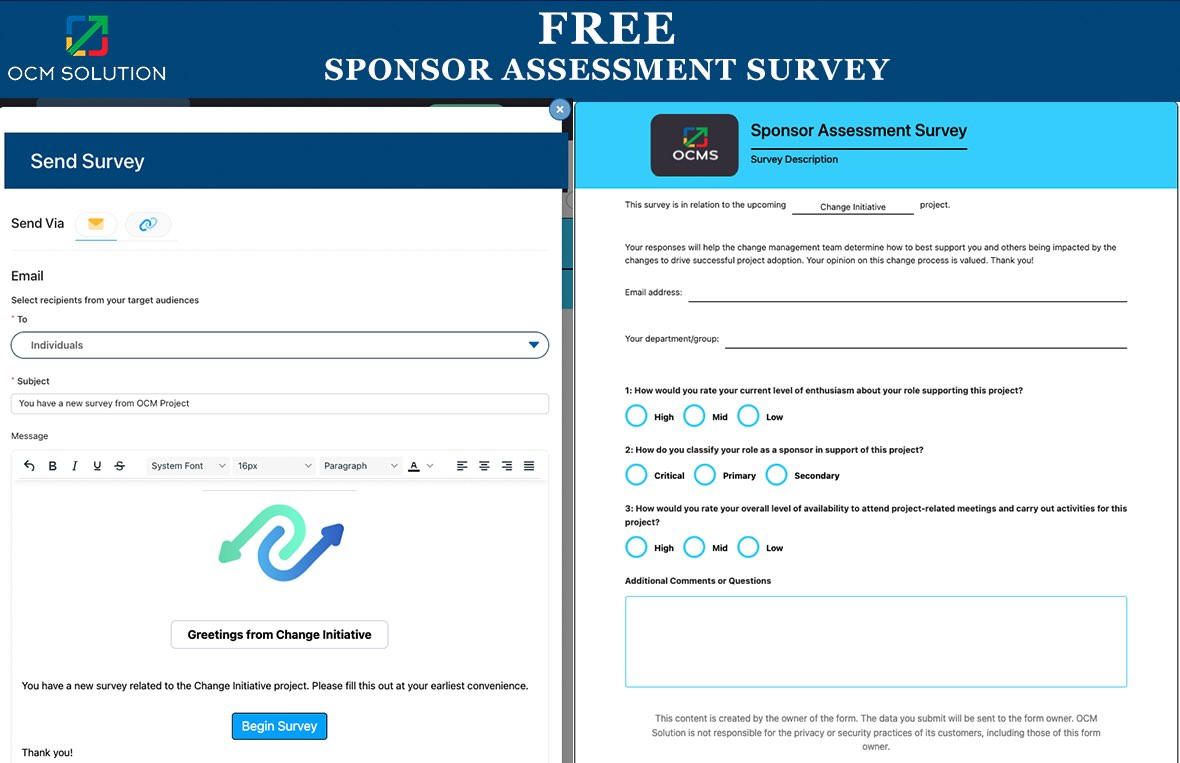
Get this change management survey sample for free, along with many other free resources when you sign up for a Free Trial of the OCMS Portal!
Change Adoption and Engagement Metrics
To increase change adoption and the success of a project, program, or transformation initiative, your change management efforts should involve tracking and measuring user adoption change management metrics and proficiency KPIs.
A user generally goes through the stages outlined below during their transition from their current state to a desired future state:
- Stage 1: Initial Stage (Has a Lack of Awareness about the Change)
- Stage 2: Gains Awareness
- Stage 3: Resists or Questions the Change
- Stage 4: Accepts the Change
- Stage 5: Learns New Skills & Knowledge for the Change
- Stage 6: Builds Proficiency
- Stage 7: Sustains the Change
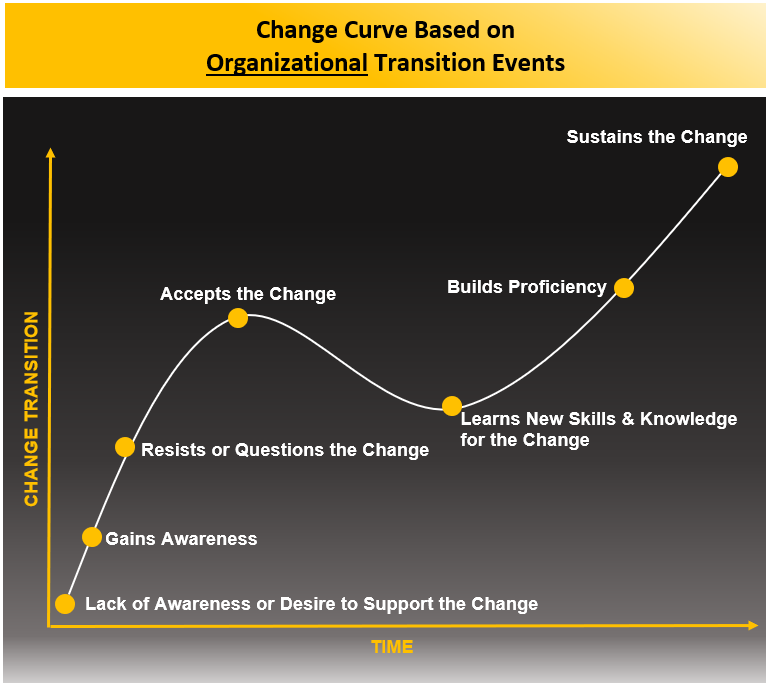
User adoption metrics examples will include things like the stakeholder’s ability to get support once the project goes live, the person’s experience with the project and how it impacts them, and proficiency in using the new process/system.
If you’re wondering how to measure adoption, a best practice is to measure it both before and after the project’s go-live date. When you measure adoption KPIs prior to go-live, it provides you with a baseline to see what else you need to do to ensure successful adoption of the project solution once it’s deployed.
Enter this information into your user adoption dashboard and then about 1-2 weeks after the project’s go-live date, survey users again to gather the updated change management measurement for user adoption KPIs. The goal is to see an improvement in the adoption KPIs showing that users are successfully adopting and normalizing the changes.
When you sign up for a free trial of the OCMS Portal change management app, you get a free change management adoption survey included!
Here are some user adoption metrics examples:
- Access to the New Tools/System
- Track access to new systems, solutions, processes, policies, etc. Email impacted groups and ask them to test their access.
- Track that everyone has access.
- Do Users Know How to Get Help & Support?
- Remind impacted groups of where they can find help or additional resources.
- Track how often people are coming back with questions. An increase in the number of questions means additional enablement needs to be provided before Go-live.
- Users’ Feeling of Readiness for the Change
- Survey impacted groups to determine how ready they feel for the change.
- If people don’t feel confident using the new project solution, they are likely to abandon the changes they learned and go back to old systems and processes. This equates to project failure.
- Users’ Overall Experience with the Transition
- Find out how the experience has been for users, both going through the transition training and post-go-live after being expected to adopt the changes.
- Users’ Proficiency in Adopting the Changes
- Knowing how to use a new process/tool and being proficient are two different things.
- People won’t use a process if it takes them longer than the old process because they aren’t as proficient. If you see proficiency is low, more training may be needed to raise it.
How to Measure Adoption
- Speak with managers
- Ask change champions to track user proficiency in using the new tool
- Track the number of frequently asked questions being asked about the new process, policy, culture, or other change.
- Observations of behavioral change
- Use a change management adoption survey
- Review the project team’s Project KPI, metrics, and measurements to identify how users are meeting project metrics
- Send out surveys asking people to rate their overall transition to using the technology, platform, tool, or solution
- Enter the results to calculate an Overall User Adoption Score (see the screenshot below for an example)
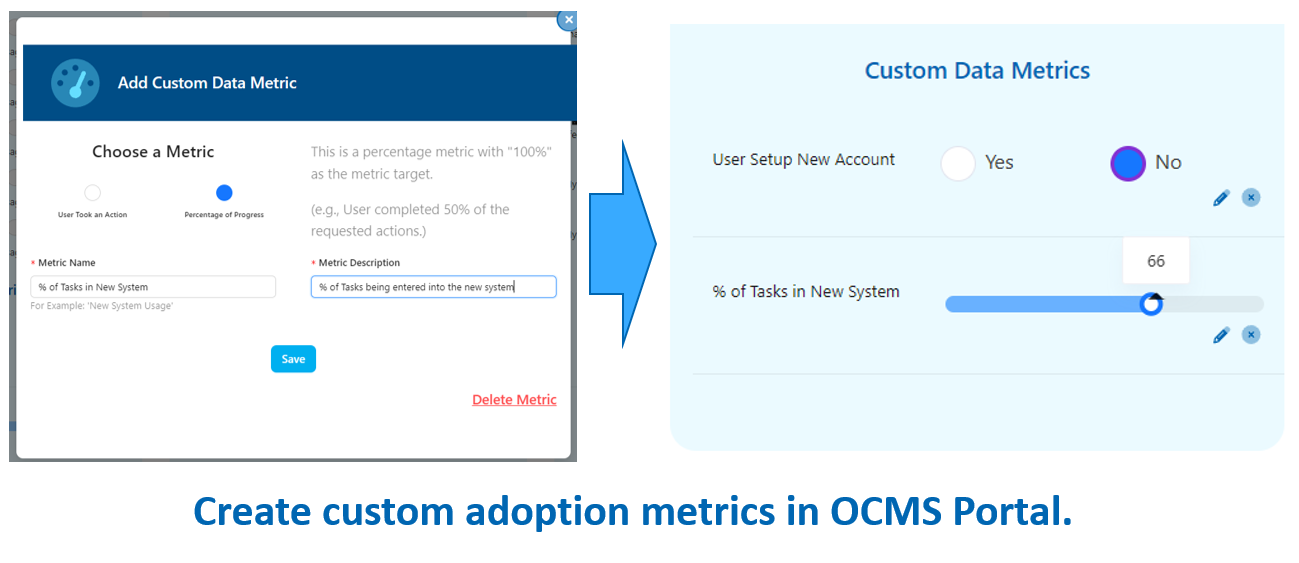
OCMS Portal change management measurement tools for go-live assessment and adoption allow the flexibility to enter your own custom adoption metrics.
Please let us know if you have any questions related to external or internal communication goals, successful change management examples of KPIs and metrics, outcome measurement strategies for organizational change, or how to use an automated change management tracker. We’ll be happy to help!
How to Measure Organizational Effectiveness Using Change Management Reporting
At the end of the day, all of the change metrics and KPIs discussed in the sections above are irrelevant if you are unable to gain insights from them.
A key component of effective measurement involves assessing the KPIs change management teams need to identify trends and key insights. Are the metrics pointing in the right direction or are they showing signs that your change deliverables are not being very successful in increasing change adoption?
Readiness Engagement
For example, when doing change measurements for readiness KPIs, you need to understand what engagement to plan when scores for things like support, knowledge, and awareness are low.
What to Do:
- A low or mid-range overall readiness score signifies that a high level of change management will be needed to increase receptiveness and change adoption. As such, you will need to pivot or modify your change management activities to resolve negative trends.
- In the case of low support for the project, your change management activities should involve getting more leadership and change champion involvement with impact groups to help transition those groups from low support to a higher support level.
- If you see that awareness levels are low, this indicates more communications regarding the change impacts are needed. Make sure you personalize the details for each impacted group.
User Adoption & Experience
How well are your overall user adoption and overall experience metrics performing? Are you seeing a high level of user adoption? If so, it means your change management activities have been successful. What if your adoption metrics are showing low adoption?
What to Do:
In a situation where you are seeing poor adoption rates, you will need to reevaluate and modify your change management strategies. Part of this reevaluation should be to find out why adoption rates are poor. If you don’t know the “Why,” you can’t properly address the problem.
Communication KPIs
What insights are you gleaning from your communication KPI metrics? Are you seeing a high performance in your communication activities and deliverables? Are your communications being received and read? Are users engaging with your communications? Are you seeing the expected outcomes?
What to Do:
In situations where you are seeing low communication reach, engagement, and outcomes, you should re-evaluate your communication messages, delivery mechanisms, and objectives. Are you just using email to send your communication? If so, you should consider also having leadership send out the communication, having change champions review your communication message and provide feedback, having managers waterfall down the communication to their direct reports, etc.
Training KPIs
If your training metrics dashboard is showing a positive performance then it’s a great sign that your training delivery, program, and curriculum are successful. And if you are seeing low or mid-range measurements, then you will need to reevaluate your training program and delivery.
What to Do:
Make sure to speak with trainees, change champions, managers, and other stakeholders to identify the issues and what needs to be resolved to increase training performances.
If your training KPIs examples from an ADKAR survey, OCM Solution survey, or another training survey are indicated proficiency is low, then you may need to schedule and conduct more training sessions.
What Metrics Do You Use to Drive Positive Change? | Change Initiative Types
What are the various types of change initiatives that should be tracked using the change management KPI metrics presented on this page to drive positive change?
Below is a sample list of different change initiatives that require change management and effective OCM tracking of end-user change adoption.
- Organizational changes:
- Corporate change
- Business change
- Departmental change
- Governmental change
- Non-profit organization change
- Social change
- Changes within an educational institution
- Healthcare restructuring
- and many more
- New process changes
- Technology solution changes
- Upgraded/enhanced processes
- Culture changes
- CRM/ERP/Business/Finance/HR/Operational system integrations
- HR transition
- Mindset/skillset changes
- Post-M&A integration
- Social or economic changes
- New product launch
- Business expansion
- And any kind of organizational change
Note, this next section is specifically about change management KPI metrics in ITIL, another type of change management. If you are interested in how to measure employee engagement metrics instead, then you can skip past that to the next section.
Change Management KPI Metrics in ITIL
ITIL change management metrics for software and other technology-centric developments are centered around “what does success look like,” which is known as Critical Success Factors (CSF).
ITIL Change Management KPIs are a list of things that need to be successful for a process to be considered successful. When tracking the success of an ITIL change implementation you want to track one or more KPIs from the following list.
- Reduction in the number of unauthorized changes
- Reduction in the change requests backlog
- Reduction in the number of changes rejected due to any reason
- Reduction in the percentage of unauthorized implemented changes in a given period. What is an unauthorized implemented change? This is when a change has been developed and implemented without an authorized change request
- Reduction in the percentage of failed changes
- Reduction in the number of incidents caused by changes
- Increase in overall change success rate
- Increase in the overall percentage of the total number of closed emergency changes in a given period
- Reduction in the number of service downtime caused by changes
- Reduction in the number/percent of unplanned/emergency changes
- Reduction in the average time needed to implement changes
- Increase in the number of successful changes implemented in a particular time frame
- Increase in the number of successful changes implemented without accident
The IT Key Performance Indicators (KPIs) table below published by Micro Focus provides a great summary of ITIL metrics that you should take into consideration when tracking the success of your technology changes and change requests.
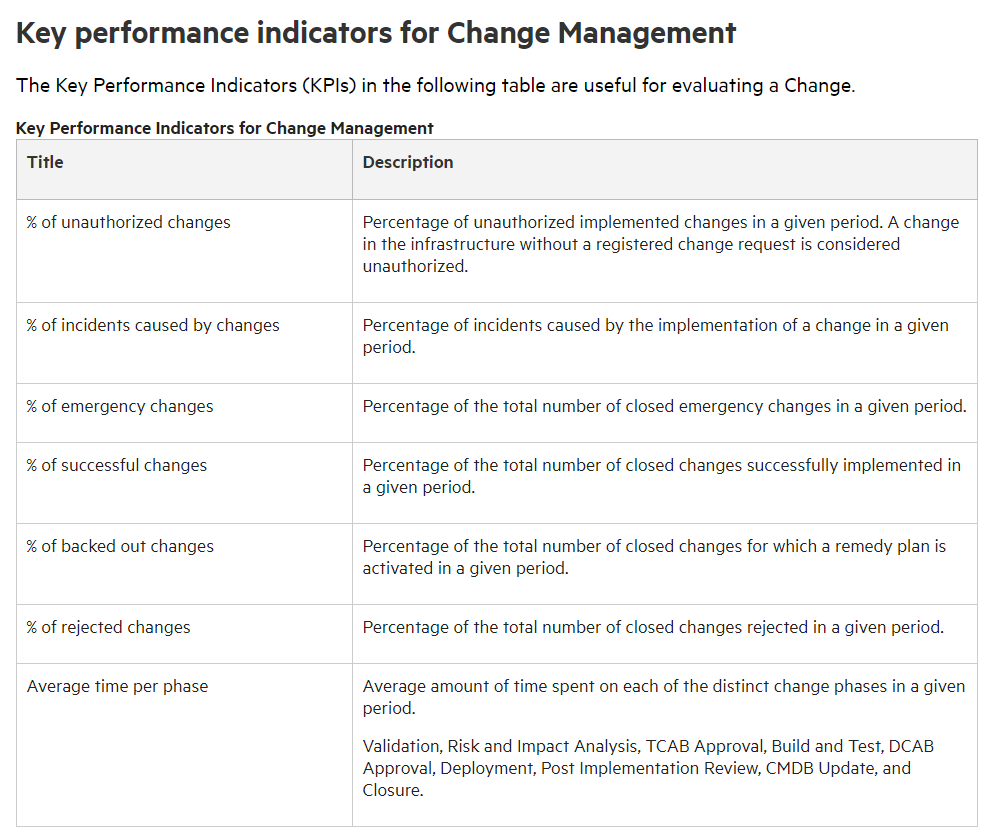
And here is another table from ITIL® Process Map that you can leverage.
Key Performance Indicators for Change Management from the ITIL Process Map.
OCM Tracking Dashboard for Measuring Change Success
One request we hear from change management practitioners often is the need for one consolidated KPI Change Management Dashboard that can be used to summarize the most important KPIs across all change management activities.
A single dashboard to report on project risk areas as well as the success of change management in driving project adoption. You can find this in the OCMS Portal.
The Change Metrics & KPI Dashboard imports the change metrics from several key areas of change management, including communications, readiness assessment, stakeholder management, training, change impact assessment, and more.
It provides a single pane of glass to see KPIs for change management across the entire organization and end-to-end throughout your change activities and workflow.
It includes:
- Training KPI metrics
- KPI for communication reporting
- Readiness KPIs
- User adoption metrics
- Stakeholder and leadership metrics examples
- Change impact metrics for project success
- Change management effectiveness for coaching
- Effectiveness of change management training
- Resistance to change measures tracking
- And the ability to create custom reports from your project’s tailored change management dashboard
This time-saving tool that increases the success of change management activities is available exclusively in the OCMS Portal All-in-One Change Management Platform.

Dashboard Reporting for Measuring Change in an Organization
You can test drive the OCMS Portal tool for tracking change management success metrics, right now! Just sign up for a free trial below (no credit card needed).
Conclusion | How to Monitor Change in an Organization with KPIs and Metrics
We hope this comprehensive guide on the best change metrics and KPIs for measuring change management success has been useful to you.
Practitioners sometimes neglect to track change management key performance indicators. But, without tracking these change KPIs, you will miss key insights on the effectiveness of your change management deliverables.
Having the right tool to provide insightful reporting on change measurement metrics is vital to enable you to provide reporting to key stakeholders, leadership, sponsors, and others. It also helps you identify areas of the project that need attention before something negatively impacts user readiness or user adoption of the changes.
FAQ | How to Measure Change Management Activities
How do you measure effective change management?
The best ways to measure change management effectiveness are through change management evaluation across multiple engagement activities, such as:
• Impact assessment
• Stakeholder assessment
• Coaching
• Training
• Communications
• Resistance management
• Champions network deployment
• Adoption change management assessment
How to measure success of change management?
There are various ways for measuring the success of your change management programs. The most common is to track your communications, training, stakeholder engagement, and change adoption metrics and KPIs.
You should also use a baseline readiness project metrics template and compare those KPIs to post-go-live readiness & adoption metrics.
What are the KPIs of change management?
Organizational change management KPIs and metrics include tracking the awareness of your communications amongst your communication target audience groups, as well as tracking training success KPIs and engagement metrics. Other KPIs include how often people are using a new system or process.
What Are Project Management Metrics vs Change Management Metrics?
Project management metrics are related to the technical deployment of a project. These may include bug identification or timeline tracking to identify whether the project is running behind.
Change management metrics are related to preparing people for the changes that need to be adopted and ensuring those changes are successfully adopted once the project solution is deployed.
Note: Content on OCM Solution's ocmsolution.com website is protected by copyright. Should you have any questions or comments regarding this OCM Solution page, please reach out to Ogbe Airiodion (Change Management Lead) or the OCM Solutions Team today. OCM Solution was previously known as Airiodion Global Services (AGS).
External sources: stock.adobe.com, microfocus.com, IT Process Maps (https://wiki.en.it-processmaps.com/index.php/ITIL_Key_Performance_Indicators)



